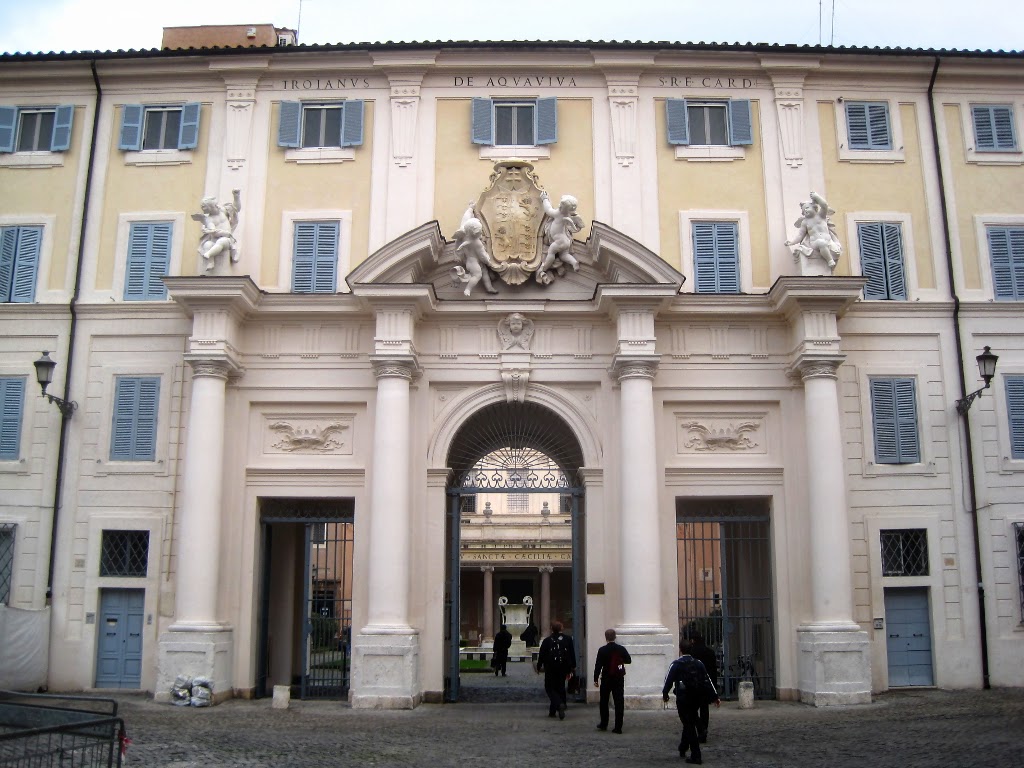Santa Cecilia in Trastevere
Today's station church is found in the Trastevere neighborhood of Rome. It is west of the Tiber and a bit south of St. Peter's. Luckily for us, that means it's much closer to the NAC, so this morning I enjoyed 15 more minutes of sleep.
St. Cecilia is a wonderful wonderful saint. She is the patroness of musicians, and in Christian art is very often pictured with a musical instrument (typically an organ or viola). Although I would like to know more about that, since she was alive way before organs and violas existed.
Cecilia was a Roman maiden of the early third century engaged to be married to a pagan named Valerian. After their marriage, she brought him to Pope Urban I and following this meeting, Valerian had a vision which led him to convert. The conversion of his brother Tiberius would soon follow, and subsequently the two began burying the remains of the Christian martyrs. This of course attracted the suspicion of Roman authorities, who demanded that they sacrifice to a statue of Jupiter. They refused and so were beheaded. Cecilia was next arrested and condemned to suffocation in the bath of her house. Miraculously the suffocation did not harm her, so the Romans decided to cut off her head, too.
Alas, after three strikes of the ax she was wounded but not killed. Roman law forbade more than three strikes, so she was left there to die of her wounds. Cecilia persisted for three days but in that time was visited by Urban. She gave over her possessions to the Church and asked that her home be turned into a place of worship of God. This brings us to the spot upon which today's church is built.
 |
| You enter the courtyard of Santa Cecilia through this archway, built in 1724 by Ferdinando Fuga. |
In the latter half of the 300s, the first shrine to this saint was built on St. Cecilia's home. Pope St. Paschal I (+824) replaced it with a proper basilica, at which time her remains and those of her companions were moved here from the catacombs of St. Callistus. She is buried with Ss. Valerian, Tibertius, and the Popes Ss. Urban I and Lucius I.
When you enter the church and move directly to the right, you come to the Chapel of the Caldarium, which is built over the bath of the house of St. Cecilia where the Romans tried to suffocate her. Per usual, many centuries of renovations give the church its present appearance. Some items of note: the mosaic in the apse (sorry it looks really green) is from the ninth century. The campanile outside and exterior porch were built a little further on in medieval times. Also from this time is the tall Gothic covering thing over the high altar. It's called a ciborium or a baldacchino (it's quite beautiful up close), and it was completed in 1293 by Arnolfo de Cambio, who also did the ciborium for St. Paul Outside the Walls.
But the real artistic treasure of this church is beneath the altar. It is a marble statue of St. Cecilia sculpted by the artist Stefano Maderno right around the year 1600.
Stefano was present when St. Cecilia's tomb was last opened in 1599. Amazingly, she was found to be in an incorrupt state, and the following year Stefano sculpted this statue which depicts the position of Cecilia's body in death. You can see the gash wound on her neck, but despite the violence done her, she still appears to sleep peacefully. Always a great reminder of the final resurrection which awaits all of us, so thank God for Lent when we can work a little harder at getting ready for that day.



No comments:
Post a Comment